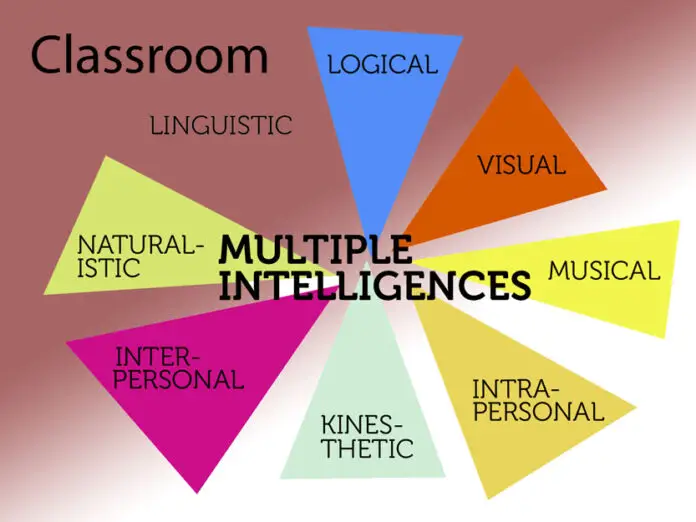Application of Multiple Intelligence in Science Classroom
In a science classroom, the Multiple Intelligence theory can be applied to engage students and enhance their understanding of scientific concepts. Here are some detailed examples of classroom activities that incorporate different intelligences:
Application of Linguistic Intelligence:
In the science classroom, linguistic intelligence plays a vital role in helping students communicate scientific ideas, articulate their observations, and construct coherent explanations. By engaging in activities such as scientific writing, discussions, and presentations, students develop their language skills and learn to express complex scientific concepts with clarity and precision. Nurturing linguistic intelligence in the science classroom fosters effective communication, critical thinking, and a deeper understanding of scientific principles.
Classroom Activity: Science Debate
Divide the class into small groups and assign each group a scientific topic or concept to research and debate. Students can use their linguistic intelligence to gather information, formulate arguments, and present their viewpoints in a structured debate format. This activity encourages critical thinking, communication skills, and the ability to express scientific ideas effectively.
Application of Logical-Mathematical Intelligence:
Logical-mathematical intelligence is an essential aspect of scientific inquiry and problem-solving. In the science classroom, students engage in activities that require logical reasoning, data analysis, and the application of mathematical concepts. By designing and conducting experiments, interpreting data, and drawing logical conclusions, students develop their logical-mathematical intelligence. This intelligence equips them with the ability to think critically, make connections, and approach scientific investigations with a systematic and analytical mindset.
Classroom Activity: Data Analysis and Graphing
Provide students with a set of scientific data, such as temperature measurements or plant growth observations, and ask them to analyze and interpret the data. Students can use logical-mathematical intelligence to identify patterns, create graphs, and draw conclusions based on the data. This activity promotes analytical thinking, data interpretation, and mathematical reasoning skills.
Application of Spatial Intelligence:
Spatial intelligence plays a significant role in understanding and visualizing scientific concepts in the three-dimensional world. In the science classroom, students explore models, diagrams, and illustrations to comprehend complex spatial relationships. They develop the ability to mentally manipulate and visualize scientific phenomena, such as molecular structures, geological formations, or the movements of celestial bodies. Fostering spatial intelligence enhances students’ ability to analyze, interpret, and communicate scientific information effectively.
Classroom Activity: Model Building
Ask students to create physical models or diagrams to represent scientific concepts or processes. For example, they can build a model of the solar system or construct a 3D representation of a cell. This hands-on activity allows students to engage their spatial intelligence by visualizing and manipulating objects in space, deepening their understanding of scientific concepts.
Application of Bodily-Kinesthetic Intelligence:
Bodily-kinesthetic intelligence finds expression in the science classroom through hands-on experimentation, laboratory work, and the manipulation of scientific tools and equipment. Students engage their senses and motor skills to make observations, perform experiments, and gather data. By actively participating in scientific activities, such as dissections, chemical reactions, or physics experiments, students develop a deep understanding of scientific concepts and enhance their ability to apply theoretical knowledge to practical situations.
Classroom Activity: Science Experiments
Conduct science experiments that require hands-on involvement, such as mixing chemicals, measuring and pouring liquids, or conducting simple physics experiments. These activities allow students to engage their bodily-kinesthetic intelligence by actively manipulating materials, performing experiments, and making observations. This fosters a deeper understanding of scientific principles through experiential learning.
Application of Musical Intelligence:
In the science classroom, musical intelligence can be tapped into to enhance the learning experience and retention of scientific concepts. Students can create mnemonic devices, songs, or jingles to remember key scientific facts, formulas, or processes. Musical elements, such as rhythm, melody, and repetition, help students encode scientific information in a memorable and engaging way. By integrating musical intelligence, science educators facilitate a multisensory approach that promotes creativity, memorization, and conceptual understanding.
Classroom Activity: Science Jingles or Raps
Ask students to create jingles or raps that explain scientific concepts or processes. They can compose catchy tunes or lyrics to convey scientific information. This activity allows students to apply their musical intelligence by using rhythm, melody, and lyrics to reinforce their understanding of scientific content, making it more memorable and enjoyable.
Application of Interpersonal Intelligence:
Interpersonal intelligence is valuable in the science classroom as it encourages collaboration, teamwork, and the exchange of scientific ideas. Students engage in group discussions, cooperative learning activities, and peer-to-peer teaching. They learn to communicate their scientific knowledge, debate viewpoints, and work together to solve problems. By nurturing interpersonal intelligence, science educators foster a sense of community, promote effective communication, and develop essential interpersonal skills necessary for scientific collaboration and exploration.
Classroom Activity: Group Investigations
Assign students to small groups and provide them with a scientific investigation or problem to solve. Each group can collaborate, conduct experiments, and analyze results together. This activity promotes interpersonal intelligence as students work together, share ideas, and engage in cooperative learning. It also develops teamwork, communication, and problem-solving skills.
Application of Intrapersonal Intelligence:
Intrapersonal intelligence in the science classroom focuses on self-reflection, metacognition, and individual exploration. Students have opportunities for independent research, self-directed investigations, and reflection on their learning processes. Through activities such as journaling, self-assessments, or goal-setting, students deepen their understanding of their own learning preferences, strengths, and weaknesses. Nurturing intrapersonal intelligence in the science classroom promotes self-awareness, self-regulation, and a sense of personal ownership over the scientific learning journey.
Classroom Activity: Self-Reflection Journals
Provide students with regular opportunities for self-reflection through journaling. After conducting experiments, studying scientific concepts, or engaging in class discussions, students can write in their journals to express their thoughts, reflections, and questions. This activity encourages intrapersonal intelligence as students develop self-awareness, critical thinking, and a deeper understanding of their own learning processes.
Application of Naturalistic Intelligence:
Naturalistic intelligence in the science classroom involves connecting scientific concepts to the natural world and exploring the interrelationships between living organisms and their environment. Students engage in fieldwork, outdoor observations, or ecological studies to understand biodiversity, ecosystems, and environmental phenomena. By nurturing naturalistic intelligence, science educators foster an appreciation for nature, instill a sense of environmental responsibility, and cultivate scientific curiosity through firsthand experiences with the natural world.
Classroom Activity: Nature Observation and Documentation
Take the students outside to explore the natural environment, such as a school garden, park, or nearby ecosystem. Students can observe and document plants, animals, and ecological interactions. They can create nature journals, take photographs, or make sketches. This activity allows students to engage their naturalistic intelligence by developing their observation skills, appreciating biodiversity, and understanding the interconnections within the natural world.
By incorporating these activities that tap into different intelligences, science teachers can create a dynamic and inclusive learning environment that caters to the diverse strengths and abilities of their students.





Thank you for these practical tips. It is need of the time. You outline practical activities.